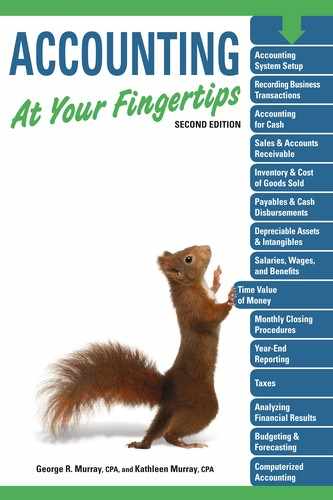Book Description
Most small business owners learn early on that it's much cheaper to do their own books (alone or with the assistance of a bookkeeper or accounting clerk) and have them reviewed by an accountant than to have a CPA on staff. With a steady supply of entrepreneurs opening new businesses, there's a real need for a one-stop accounting reference busy owners, bookkeepers, and accounting clerks can use to access the specific information they need quickly and accurately. Accounting at Your Fingertips, Second Edition, helps readers pinpoint the precise information they need on any accounting topic without wasting time.
Divided into concise but complete bites that are easy to find and easy to understand, Accounting at Your Fingertips, Second Edition, covers all topics related to the monthly accounting process. Based on the notion that time is the scarcest commodity of all, this book is organized to allow readers the shortest path to the information they need, including:
- Organization and proper accounting procedures.
- Creating a chart of accounts and balance sheet accounts.
- Posting accounts to the general ledger.
- Reporting assets and expenses.
- Handling receivables, payroll, and cost of goods and services.
- Posting salaries, wages, and payroll taxes.
- End-of-month accounting tasks and procedures.
- Producing balance sheets, profit and loss statements, and end-of-year payroll reports.Closing the books at the end of the year.
Table of Contents
- Cover
- Title Page
- Copyright
- Contents
- Introduction
- Chapter 1 Accounting System Setup
- Chapter 2 Recording Business Transactions
- Chapter 3 Accounting for Cash
- Chapter 4 Sales and Accounts Receivable
- Chapter 5 Inventory and Cost of Goods Sold
- Chapter 6 Payables and Cash Disbursements
- Chapter 7 Depreciable Assets and Intangibles
- Chapter 8 Salaries, Wages, and Benefits
- Chapter 9 Time Value of Money
- Chapter 10 Monthly Closing Procedures
- Chapter 11 Year-End Reporting
- Chapter 12 Taxes
- Chapter 13 Analyzing Financial Results
- Chapter 14 Budgeting and Forecasting
- Chapter 15 Computerized Accounting
- Appendixes
- Index
- About the Authors
